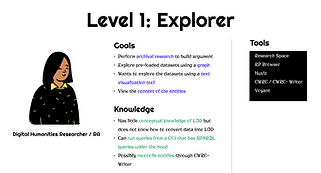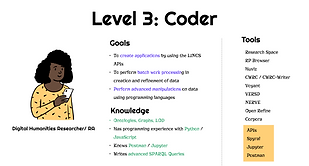Canadian Researchers (Digital Humanities) can create datasets and publish while also making it accessible to others across the web through Linked Open Data where datasets are created using Ontologies. Additionally, they also use open-source tools like -- Huviz, Voyant, Spyral, Research Space etc. to create visualizations of the research data to support their thesis.
While these make this available across the web through Linked Open Data , the LINCS project @ University of Guelph in the Department of Digital Humanities initiates to provide a one-stop access and free platform for all researchers.
For more information, check their website LINCS.
users
Digital Humanities Students and Canadian Researchers with limited to no experience of computer knowledge and/or Linked Open Data concepts
outcome
As a result of 13 developer interviews and more than 25 User interviews (Canadian researchers)- personas were created based on level of computer knowledge and LOD (Linked Open Data) concepts.
Creating workflow diagrams and Tube maps helped represent the different multiple paths that can be taken by Canadian researchers to achieve their goal.
tools
Google Jamboard
Co-creation design with development team
Zoom
Remote Interviews and Team collaboration
Figma
Presentations, workflow diagrams & Tube maps
* * Remember whenever you read "tools" I mean the Digital Humanities visualizations Tools
RESEARCH
Since there was no existing digital Interface, understanding the workflow of the tools existing was very important - which included the pre-requisites and the user competencies. And this was possible through the 13 interviews of the developers / experts of these tools.

Pre-requisites
Technical and conceptual pre-requesites for users to use the tools or interfaces available through the LINCS Access Interface.
Source: 13 Developer interviews
user competencies
The common functionalities and user competencies across the tools. The visual representation through a venn diagram served a better picture for a product that is still in its initial stages.
Source: 13 Developer interviews & LINCS Team

Who are the users?



I used the analogy of levels of a Game with Levels of Knowledge about Linked Open Data, from a novice player who is just exploring using the visualization tools, to a contributor in curating datasets for research, to then being a coder who knows the in and out of Linked Open Data in creating Knowledge graphs (similar to google knowledge graphs algorithm but non-proprietary).
NEEDS
-
To create Knowledge patterns or visualise research data in an easy and simple way using the digital humanities tools for free.
-
To know what tools to access to process the data to support the thesis paper.
-
To be able to use tools to link research datasets in order to make it available across the web.
User flows



From my rough paper prototyping of analysis and user flow diagrams....
(I love to first visualise it on paper and post-its)...
........To creating a polished version of workflow diagram on Figma.
(workflow shows how a user can use the tools to perform the required actions - all that can be accessed through the LINCS access interface)

Lincs tube map

Since there are multiple paths a researcher can take with regards to creating / visualizing research datasets or creating Linked Open Data through various tools, we used the analogy of a Tube station map where the passenger has different destinations and can hop off to another station.
Similarly here the researchers have diverse goals and needs that cannot be "persona-fied" within just three personas...
The LINCS Tube map allows a researcher on the LINCS access interface to be directed to various tools that are independently hosted in a simple instructional manner where the desired output can be expected with the respective path taken.
recommendations

next steps

key takeaways

interpretations

personas
Personas may not always work as they do not represent the diverse and unique mindset and goal of a peson.

team work
A great team is one who listens, collaborates with no judgment to work seamlessly together.
There will always be more than one interpretation of a concept across teams. It is good to document them all. This helps in facilitating everyon'e understanding.
Image Sources : www.nounproject.com, www.freepik.com, www.undraw.co
